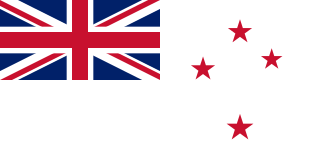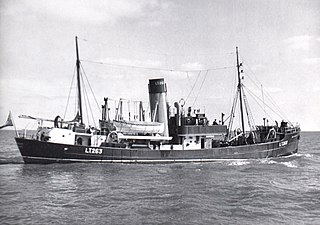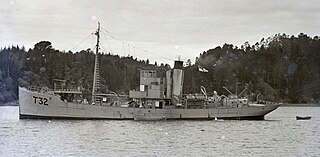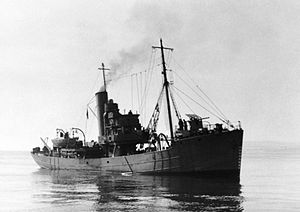
A minesweeper is a small warship designed to remove or detonate naval mines. Using various mechanisms intended to counter the threat posed by naval mines, minesweepers keep waterways clear for safe shipping.

The Isles-class trawlers were a class of naval trawler used by the Royal Navy, Royal Canadian Navy and Royal New Zealand Navy during World War II.

The Hunt-class minesweeper was a class of minesweeping sloop built between 1916 and 1919 for the Royal Navy. They were built in two discrete groups, the earlier Belvoir group designed by the Ailsa Shipbuilding Company and the subsequent Aberdare group designed by the Admiralty. They were classed as Fleet Minesweeping Sloops, that is ships intended to clear open water. The Belvoir group were named after British fox hunts. Those of the Aberdare group were originally named after coastal towns, watering places and fishing ports, some of which happened to be hunts by coincidence. However, all were soon renamed after inland locations to prevent confusion caused by the misunderstanding of signals and orders.

The Ton class were coastal minesweepers built in the 1950s for the Royal Navy, but also used by other navies such as the South African Navy and the Royal Australian Navy. They were intended to meet the threat of seabed mines laid in shallow coastal waters, rivers, ports and harbours, a task for which the existing ocean-going minesweepers of the Algerine class were not suited.

HMS Bangor was a Bangor-class minesweeper of the Royal Navy that served during the Second World War. She was built at the Harland and Wolff shipyard in Govan, Scotland. Bangor was the lead vessel of her class and one of the diesel-engined versions. She was ordered on 12 July 1939, laid down on 19 September 1939, launched on 23 May 1940, and commissioned on 7 November 1940. She is named after the Northern Ireland seaside town of the same name.

The British Royal Navy operated large numbers of small Motor Minesweepers (MMS) during the Second World War, in two major classes: the first with 105 ft (32 m) hulls and the second with 126 ft (38 m) hulls. Intended to counter magnetic influence mines in coastal waters, they had wooden hulls.

The Royal Naval Patrol Service (RNPS) was a branch of the Royal Navy active during both the First and Second World Wars. The RNPS operated many small auxiliary vessels such as naval trawlers for anti-submarine and minesweeping operations to protect coastal Britain and convoys.

Commissioned minesweepers and danlayers of the Royal New Zealand Navy (RNZN) from its formation on 1 October 1941 to the present. The RNZN was created two years into World War II. For coherence this article covers the war years from the start, and thus includes also the New Zealand minesweepers operating from the beginning of the war.
Vorpostenboot, also referred to as VP-Boats, flakships or outpost boats, were German patrol boats which served during both World Wars. They were used around coastal areas and in coastal operations, and were tasked with – among other things – coastal patrol, ship escort, and naval combat.

Naval trawlers are vessels built along the lines of a fishing trawler but fitted out for naval purposes; they were widely used during the First and Second World Wars. Some, known in the Royal Navy as "Admiralty trawlers", were purpose-built to naval specifications; others were adapted from civilian use. Fishing trawlers were particularly suited for many naval requirements because they were robust vessels designed to work heavy trawls in all types of weather, and had large clear working decks. A minesweeper could be created by replacing the trawl with a mine sweep. Adding depth charge racks on the deck, ASDIC sonar below, and a 3-inch (76 mm) or 4-inch (102 mm) gun in the bow equipped the trawler for anti-submarine duties.

The M class were the standard minesweeper of Nazi Germany's Kriegsmarine during World War II. The vessels were the primary force in Germany's harbor defense command and were organized administratively into minesweeper flotillas.

HMS Jason was a Halcyon-class minesweeper. She was named after the hero in Greek mythology and was the sixteenth Royal Navy ship to carry the name Jason. She was laid down on 12 December 1936, launched on 6 October 1937, and was completed on 9 June 1938. She survived the Second World War and was sold in 1946 to become a cargo ship. She was eventually broken up in 1950. Her pennant number was originally N99, but was changed to J99 in May 1940.

HMCS Kenora was a Bangor-class minesweeper that served with the Royal Canadian Navy during the Second World War. Entering service in 1942, the minesweeper took part in the Battle of the Atlantic as a convoy escort and in the invasion of Normandy. Following the war, the vessel was laid up until reacquired in 1952 during the Korean War. Never re-entering service with the Royal Canadian Navy, Kenora was sold to the Turkish Navy in 1957. Renamed Bandirma by the Turkish Navy, the vessel was discarded in 1972.
HMCS Mulgrave was a Bangor-class minesweeper that served with the Royal Canadian Navy during the Second World War. Entering service in 1942, the minesweeper took part in the Battle of the Atlantic and the invasion of Normandy. While sweeping for naval mines off France in 1944, the vessel hit one. The ship was towed back to port where Mulgrave was declared a constructive total loss. Laid up until the end of the war, the minesweeper was broken up in 1947.

RV Sir Lancelot (LT263) was a fisheries research vessel that was operated by the Directorate of Fisheries, now known as the Centre for Environment, Fisheries and Aquaculture Science (Cefas).

HMS Sharpshooter was a Halcyon-class minesweeper of the British Royal Navy. Built at Devonport Dockyard, Sharpshooter was completed in 1937. She served through the Second World War, acting both in her designed role as minesweeper and as a convoy escort, escorting several Arctic convoys. She took part in the evacuation from Dunkirk in 1940, and sank the German submarine U-655 in 1942.
Junella was a fishing trawler, best known for her service with the Royal Navy during the Falklands War. She was built in 1975 for J Marr & Son, a Hull-based fishing company. On 11 April 1982 she was taken up from trade by the British government and commissioned into the Royal Navy. She was fitted with Second World War era minesweeping gear at Rosyth Dockyard, manned by Royal Navy sailors and allocated to the 11th Mine Countermeasures Squadron. She sailed on 26 April but was unable to commence sweeping until after the 14 June Argentine surrender. In the meantime she was utilised to transfer troops and stores between ships and landed special forces troops at San Carlos. Demining operations commenced on 21 June. Junella returned to the United Kingdom on 11 August, carrying a defused Argentine mine.

HMNZS Waipu was one of eight steel New Zealand-built Castle-class ships built and commissioned by the Royal New Zealand Navy during World War II.

HMNZS Waima was one of eight steel New Zealand-built Castle-class trawlers built and commissioned by the Royal New Zealand Navy during World War II.














